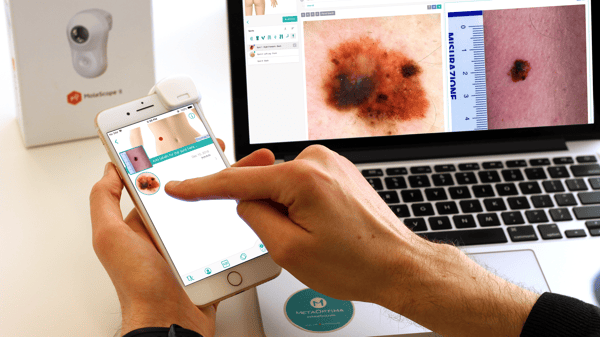-The MetaOptima Team
Would you like to remain connected with your patients & colleagues while providing streamlined care and receiving a new source of income? sign up for a demo today!
The Quest To Save Lives In And Out Of The Consultation Room: Skin Cancer Early Detection
Skin cancer is one of the most curable types of cancer that exist, however survival rates dramatically decrease if the disease is diagnosed at later stages.1 Indeed, the main focus in dermatology research has been pointed towards early detection techniques, aiming to raise survival rates with new technologies such as total body photography and teledermatology. This article will revise how these new approaches in dermatology daily practices are contributing to tackle this disease with readily available consultation services.
1. What tools are available to improve diagnosis?
An accurate and on-time skin cancer diagnosis is the ultimate goal of a dermatologist, especially in the case of melanoma- the most aggressive type of the disease. Unfortunately, despite the urgency of early diagnosis and treatment, the increased numbers of cancer cases and the shortage of skin experts is turning into a real challenge for healthcare systems with prolonged waiting periods for patients. The use of newer technological advancements for early detection of skin cancer has been at the forefront on development in dermatology practices, and recent applications have been shedding light with a renewed sense of hope:
- Teledermatology: the practice of a dermatologist providing online consultations has been one of the first uses of telemedicine. Indeed, for remote areas where access to dermatology services is virtually nonexistent, patients are able to have pictures of their suspicious skin lesions sent to a certified physician over a cloud-based dermatology software. The use of mobile devices such as smartphones are the perfect channel to act as the missing link between patients and doctors. Lesions can be received and analyzed in a few days, followed by a diagnosis that indicates the next steps in the treatment. All this happening previous to any in-person consultation, saving precious time.
- Total Body Photography (TBP): the risk of skin cancer is higher if the number of moles are higher, that’s why it’s imperative to pay close attention to the evolution of lesions. However, given the large number of them on a patient’s body, it poses a challenge. TBP developed as a way to obtain a clear picture of all moles present at a given point in time. DermEngine and other modern dermatology software are equipped with tools such as Evolution Tracker and Mole Mapping, specifically designed to identify and prioritize changes that have occurred on a high-risk mole over time.
2. The benefits brought by early detection: reduced patient trauma and reduced healthcare costs
Patient involvement as active participants of the healthcare cycle is of utmost importance in the fight against melanoma. So much so, that new equipment are offering patients the chance to take initiative in caring for their own skin. Mobile dermoscopes such as MoleScope are a new revolutionary way to obtain higher accuracy in diagnoses. In fact, dermoscopy has shown to dramatically improve the correct diagnosis and avoid unnecessary biopsies,2,3 and this is also true for teledermoscopy. As a consequence, the use of dermoscopes in mobile devices is playing a key role in the effectiveness of teledermatology practices, as doctors count on dermoscopic imaging for greater precision in diagnostic procedures.4
The power of teledermoscopy is also possible due to the transformative advancements experienced with intelligent dermatology software. DermEngine is a primary example of how the synergistic approach to combine active patient self-care and highly sophisticated analyzing tools available for doctors, all supported by the power of online connectivity. This approach is not only changing the foundations of the early battle against skin cancer to decrease the level of trauma experienced by patients, but it’s also providing great improvements in healthcare costs. In countries like Spain, for example, the practical reduction of costs shows a decrease close to 50% in favour of teledermatology services, thus relieving the public health system from unnecessary expenditures.5
Conclusion
The fight against skin cancer represents a great challenge involving different stakeholders in the process. Technology has achieved unprecedented success and allowed to open new roads towards improved dermatology services now powered by teledermatology and total body photography. Similarly, improvement in mobile dermoscopes and dermatology software are empowering patients and doctors to tackle the disease from its early stages. The combination of all these approaches has resulted in significant public health savings, but above all else it signifies the opportunity to attribute dermatology its most altruistic goal: to save as many patients’ lives as it possibly can.
1-https://www.ncbi.nlm.nih.gov
2-http://www.dermatologytimes.com
3-https://www.ncbi.nlm.nih.gov
4-https://www.ncbi.nlm.nih.gov
5-https://news.aetna.com
Topics: Dermatology Artificial Intelligence Skin Cancer EHR EMR Skin Cancer Early Detection Dermatology EMR System Melanoma Skin Imaging System Skin Analytics







